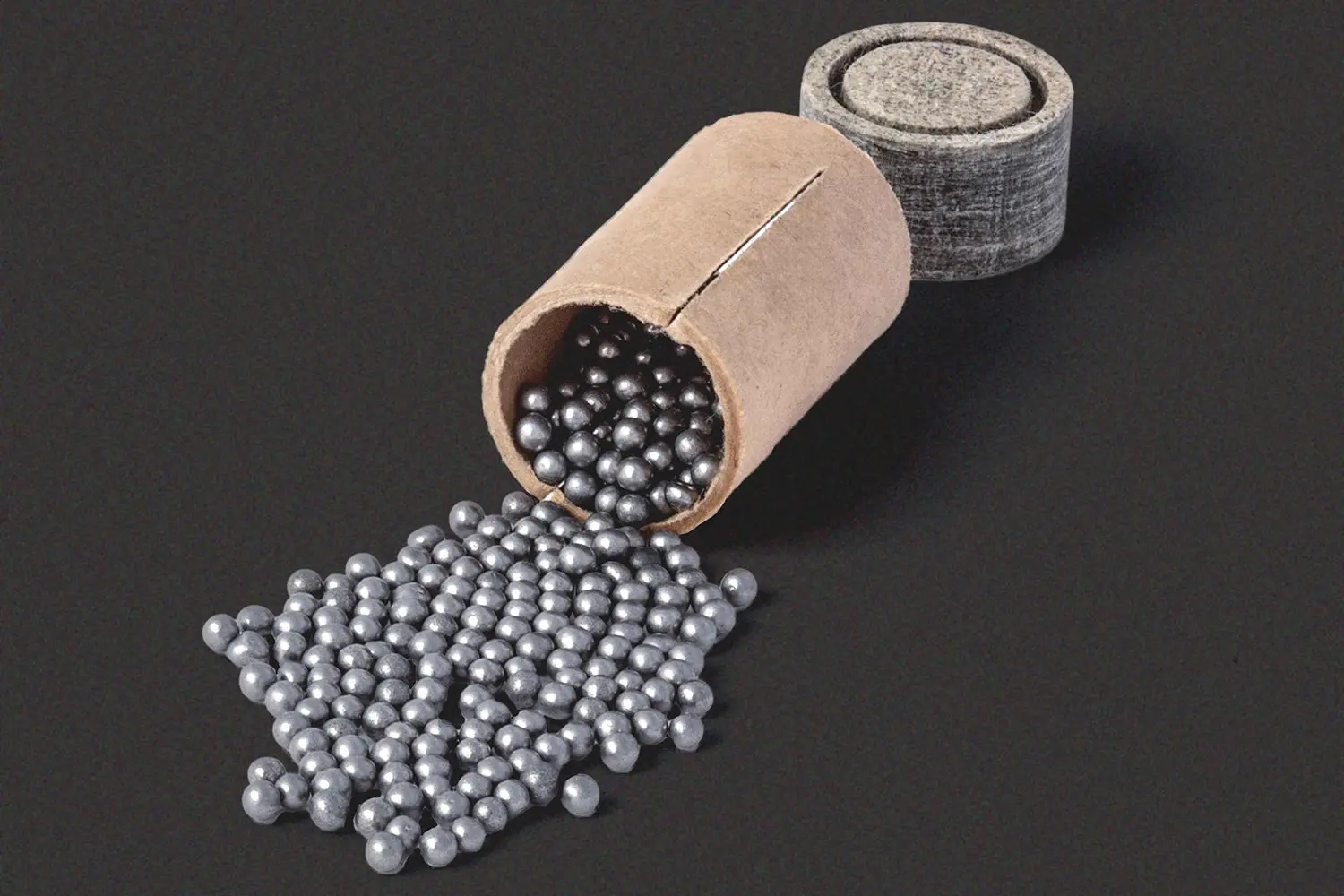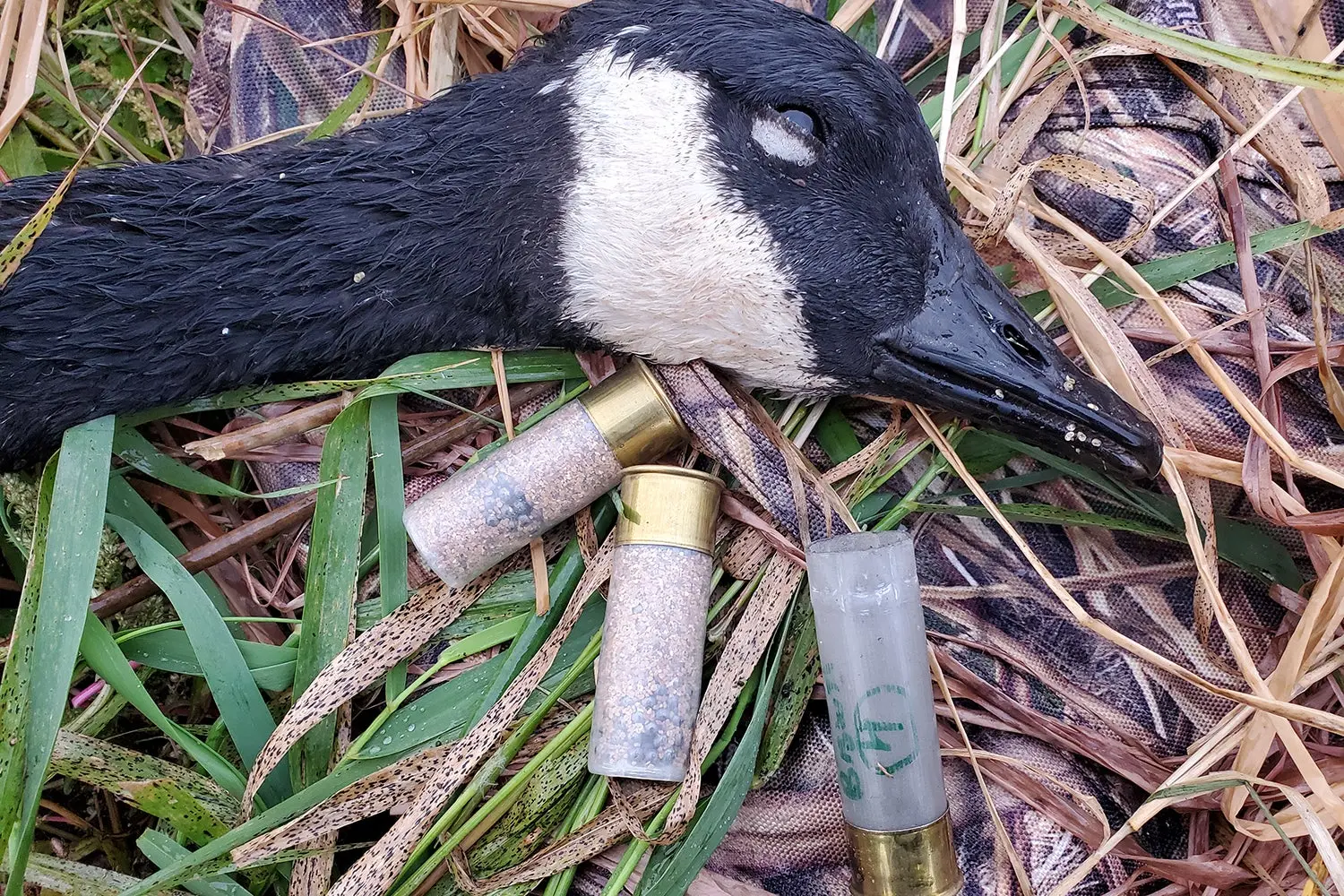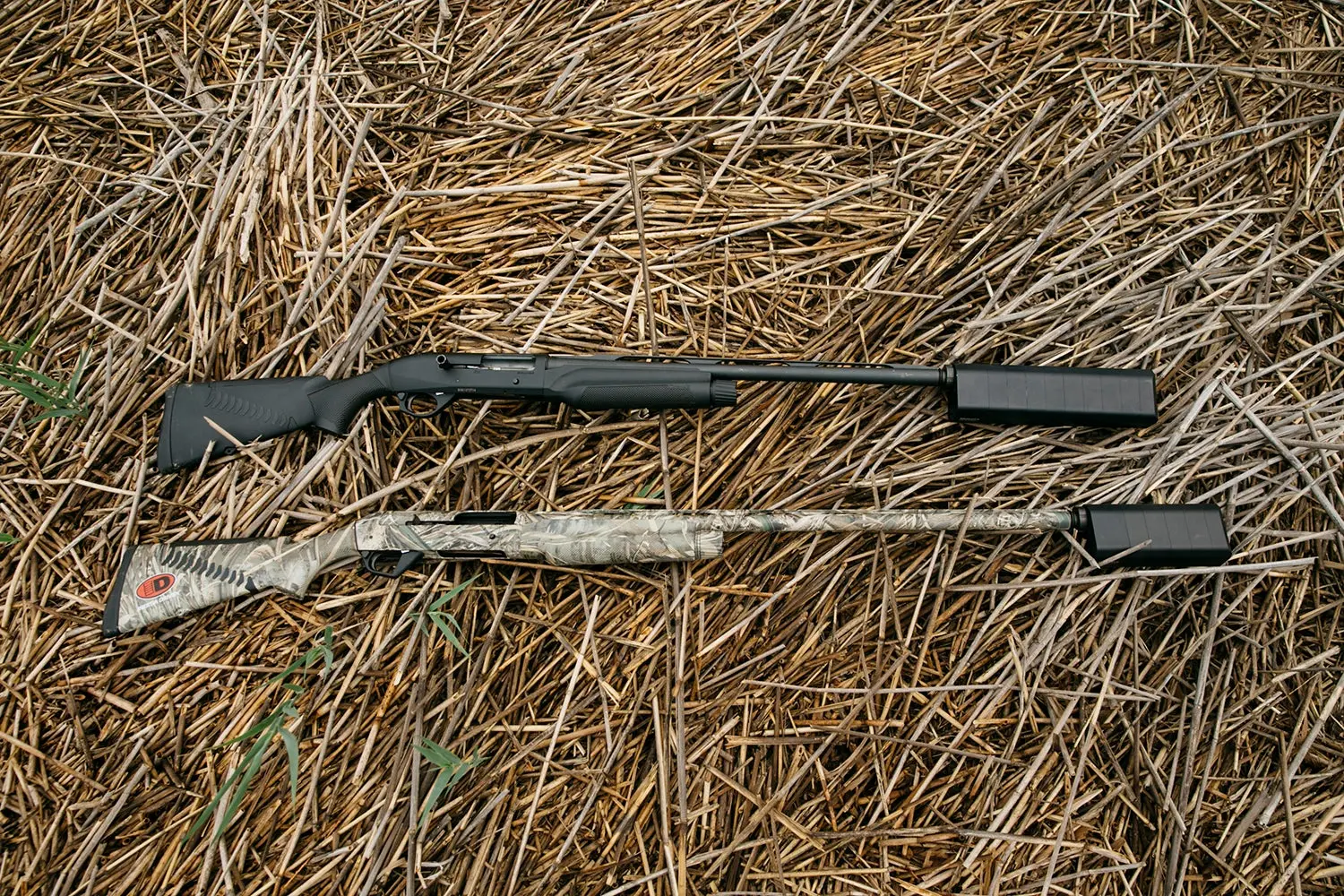_We may earn revenue from the products available on this page and participate in affiliate programs. Learn more ›
_
BIG CANADAS, little Canadas, snows, and specks lifted off the cornfield, streaming nonstop toward the lake to rest and get a drink. Noticing the pop-up blind sticking out at the end of the point, bunch after bunch detoured just out of gun range.
Finally, one pair of specks set their wings and sailed by too close. And while there was no one around to hear the shots in very rural South Dakota, the reports from our suppressed guns weren’t as loud as the normal boom of a 12-gauge. The wadding we shot into the water would be gone by tomorrow. As the Lab swam out to fetch the birds, I realized I’d had my first glimpse of what might be the quieter, greener future of waterfowling.
Noise and plastic litter pose threats to duck and goose hunting. Every wad we shoot across the landscape contains as much plastic as two grocery bags. Those wads litter the ground, and even when fired far from the ocean, they can find their way into the stomach of a sea turtle or albatross. California’s Surfrider Foundation already documents wads washing up on beaches all over the world to call attention to the problem. Some clubs and preserves don’t allow plastic wads so they can keep their grounds clean. Change will come. We can fight it and lose, or embrace our role as conservationists and be open to alternatives.
While single-use plastics are a global concern, noise is a localized problem that can cost waterfowlers access. There’s a farm near me where anyone was able to get permission to field hunt—until one still, foggy day when a party shot their limit of ducks and geese in the field. The muzzle blasts, usually blown away by northwest winds, shook the farmhouse windows, and the alarmed landowners stopped letting people hunt. Situations like that play out across the country every season.
The technology to make waterfowl hunting greener everywhere—and quieter where it needs to be—isn’t quite ready, but it’s close. Here’s what the future might look like.
The State of the Biodegradable Art
One surprise of this year’s SHOT Show was the increase in shells containing paper, fiber, or biodegradable-plastic wads. While bioplastics are new technology, there’s nothing new about fiber wads. Fiber predates the plastic shot cups and shot collars that appeared in the late 1950s and early ’60s. Plastic has its advantages over fiber: It improves patterns, it makes an excellent overpowder gas seal for consistent performance, and it protects gun barrels from damage by hard TSS, Hevi-Shot, and large-size steel pellets. Plastic also takes hundreds of years to break down. Fiber, paper, walnut shells, and bioplastics degrade quickly.
Fiber Wads
Federal now offers a line of 12-gauge, paper-wad field/target loads comprising 6 and 7½ shot in steel and lead. Designing a paper-wad shell isn’t just a matter of turning the clock back to the ’50s. Some shotgun bore diameters have remained around .725 to .729 inches, while others have gotten bigger to improve patterning. Flexible plastic wads can obturate (expand to seal) varied bore sizes in a way that conventional fiber wads could not. Without a good seal, you get powder blowby in the shell and inconsistent velocities. To fix this, Federal spent an extra year developing its new shells solely to get the basewad right, developing a paper wad with a ring cut in the bottom to create a skirt that gets forced outward by expanding gases to make a tight seal.

The ring cut at the base of Federal’s new paper overpowder wad will expand to form a tight gas seal in a shotgun barrel.
A stiff paper shot collar sits on top of the basewad and holds the shot. It protects lead shot from the bore, and the bore from small steel shot. These will be dove and target loads and should cost $2 to $3 more per box than the lead-and-plastic equivalent in the Federal lineup.
Shotshell engineer Adam Moser says Federal is working on thicker paper wads that can protect bores from larger steel pellets, and this design could be made to work with bismuth, too. At least one other U.S. manufacturer is currently working on a fiber-wad-and-bismuth shell.
Walnut Shells
Jay Menefee, the shotshell design wizard formerly behind Polywad, loaded some unusual prototype bismuth shells for me this fall. In place of a conventional wad, they contain only a layer of loose ground walnut shells. Through the magic of non-Newtonian physics, the ground shells act like a solid when the shell is fired.
I patterned and chronographed these loads and knew they worked, but I was still amazed the first time I saw one fold a Canada at 35 yards. I’ve shot enough birds with them since that they no longer surprise me. Not only do the ground walnut shells function as a gas seal, but they also seem to work as buffer, and the patterns are quite good.

The author tested these prototype shells from Jay Menefee and found them to work well on Canada geese.
According to Menefee, ground walnut shells are sold as a polishing compound, and they are easily available and inexpensive. They can be combined with paper collars to make small steel shot loads. All he needs is someone to license his idea and start selling them.
Bioplastics
Biodegradable plastics, a.k.a. “vegetal-origin biopolymers,” represent hope for wads that perform like plastic and decompose faster than fiber or paper. Spanish ammo company Rio is relaunching its Eco Blue Steel ammo containing fast-degrading bioplastic wads. I left one in a glass of water, and it was gone the next day.
The rap on bio wads is that they aren’t as stable as petro plastics and can degrade in the hull. Even high humidity can start the breakdown, their detractors say. All I can say is that I received some early samples of the Rio loads in 2019, hunted with some of them this year, and they performed fine, printing 60-percent, 40-yard patterns with a Light Modified choke and killing ducks and geese as well as any other steel 2s.
I also submerged some unopened cartridges in water, one for 15 minutes, one for an hour, and one overnight, then let them sit for a day before cutting them open. The wad in the shell that spent the night underwater had turned to goo. The others remained intact.
At SHOT, Winchester announced new E-Tech field/target steel loads with degradable plastic wads—the first result of its U.S. distribution deal with Spain’s Bioammo. Italian maker B&P showed some Green Core loads that have both fiber and bioplastic wads. Bioplastics are a European invention, and they are finding their way here. Expect to see more.
The Silent Treatment
About noise: I hate it, but I had not expected to love shooting a gun with a foot-long, 2-pound suppressor attached to the muzzle. Then I shot a clay with a subsonic target load through the SilencerCo Salvo 12 on my Browning Maxus. I heard a quiet crack, felt no recoil, and saw the target shatter. I looked at the gun and couldn’t help but giggle. Of the 10 or so people at the club who tried my suppressed shotgun, everyone had the same reaction. Less noise equals more fun.
SilencerCo Salvo 12
The Salvo 12 I took on my hunt to South Dakota is a modular unit consisting of several baffles that redirect and slow gases. It’s a bulky thing that can be adjusted to 12, 8, or 6 inches in length. The added weight and length make a gun very slow to start swinging, but the barrel doesn’t stop moving once you get it going in the right direction. You buy an adapter, which is a choke tube (various constrictions are available) with threads for the suppressor on the extension. The Salvo 12 lists for $1,169, an adapter costs $124, and you have to buy a $200 NFA stamp to purchase a suppressor. Despite the awkward balance of a long, heavy suppressor that obscures the shotgun’s bead, I had no trouble connecting on opportunities I had with my suppressed Benelli in the field.

When mounted on a shotgun with a full-length barrel, the Salvo 12 can make the gun a bit awkward. But the author found the suppressors to swing and shoot just fine.
The Metro Barrel
The other quiet option is the Metro Barrel, which has been around for some years. The long, ported aluminum-alloy Metro Barrel costs around $300. It’s classified as a choke tube by the ATF, so there’s no need to buy an NFA stamp. It has the disadvantage of being 25 inches long, although the lightweight tube is not as onerous to swing as you’d expect it to be. It is threaded at both ends so you can buy one that fits your gun’s choke system and screw the choke tube of your choice into the muzzle.
What’s Left To Be Done
Loaded with a subsonic shell running under 1,000 fps, a suppressed shotgun sounds no louder than a .22. With standard target loads, the report is still very quiet. Once you move up to heavier, faster hunting loads, the noise reduction is about 5db. That’s an audible difference, but it’s not hunt-without-earplugs-don’t-wake-the-neighbors quiet. To accomplish serious noise reduction, you need nontoxic, subsonic hunting loads, which haven’t been made since Federal discontinued the Metro Goose load. Winchester Feathers are the only widely available subsonic load I’m aware of.
What’s promising, though, is that we have the right pellets for effective subsonic loads. Heavier-than-lead TSS, HeviXII, and Hevi13 payloads don’t need to be driven at high velocities to kill cleanly because the dense shot retains energy so well. Send those pellets at 1,000 fps, and they’ll have plenty of punch. The hardest part of developing those loads—besides making a bio wad for them—will be convincing a hunting public sold on speed that super-slow loads will work.
Also, for suppressed shooting to become more popular, someone has to make a suppressor-ready shotgun. It would be a pump, so it would cycle reliably with very light loads, and the barrel would be 18½ inches to keep the overall length of the suppressed gun manageable. For the Salvo 12, the barrel would also need a rib high enough to let you see over the top of the suppressor. This seems like a perfect project for Benelli or Mossberg, if you ask me.
Viable green waterfowl loads will be here soon, and with them, if there’s enough demand, we could have subsonic gun-ammo-suppressor systems that would let you hunt without annoying the neighbors or spooking large concentrations of birds. You could shoot on a public marsh without broadcasting the location of your spot. Or it might let you put aside your loud gun for a morning and enjoy talking and joking with your friends without deafening each other—and you could do it all without leaving a scrap of plastic behind.
_Read more F&S+
stories._






